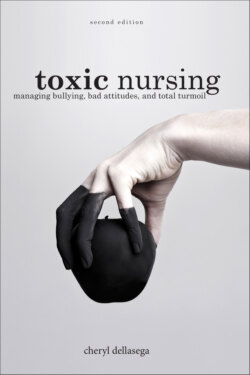Читать книгу Toxic Nursing, 2nd Ed - Cheryl Dellasega - Страница 26
На сайте Литреса книга снята с продажи.
2| the newbie: mistreatment of new nurses
Оглавление“Mature nurses” are the new “new nurses.” The traditional career trajectory for nurses used to be graduation from high school and immediate entry into a diploma or college program for nursing. After finishing, the new nurse would most likely head off to a hospital job that would last for many years, if not all of her work life. Such a homogenous group of employees led to a different type of integration into the workplace.
Now, there are multiple entry paths and a diverse assortment of nurses entering the nursing profession. According to the Bureau of Labor Statistics (2019), the most common route into nursing is as a bachelor’s degree nurse, with 12% growth predicted between 2018 and 2028. Jobs for nurses will continue to be plentiful and increase at a faster rate than other professions, but nurses may not find their work as fulfilling as in the past.
In a survey published by American Nurse Today, 10% of employees reported they were planning to leave their current position within a year, and 53% of nurse managers reported an increase in position openings within the last 12 months. There was a wide variety of educational background and age of workforce, but 40% of respondents had a bachelor’s degree, and more than half were over the age of 50 (O’Keeffe, 2017). These trends create a need for a more fluid workplace that recognizes varied motivations for seeking employment, greater complexity in coordinating care, and the need for nurse managers to be extremely flexible and versatile.
Consider a typical orientation program at a community hospital. Among the new employees are:
• Sara, a 38-year-old medic, who served in Iraq and returned to school for her BSN. She will be working part time in the ER while continuing to take classes to become a nurse practitioner.
• Luke, a 27-year-old veterinary assistant who worked his way through a two-year AD program. His dream is to be an OR nurse, but he has followed the advice of a friend to “get some experience” and taken a position on the same-day surgery unit.
• Marci and Bette, both aged 22 and freshly graduated from a four-year program and thrilled at the prospect of their first job. They have accepted positions on a busy surgical floor.
• Annette, a 40-year-old mom who is reentering the workplace after her husband lost his job. A diploma nurse, she has worked part time as a school nurse but now is headed full time for a medical unit.
One can easily imagine how challenging it will be to meet the orientation needs of this diverse group, especially with the demand to cover so many required policies and procedures. Meeting the needs of “nontraditional” nurses can be a critical determinant of retention since orientees who fail to complete their probationary period often do so because they are dissatisfied with the emotional climate of their new workplace (Dellasega, Gabbay, Durdock, & Martinez-King, 2009).
Among the conflicts a nurse manager confronts, none can be as disheartening as the “eating our young” phenomenon (Dellasega, 2009). The literature, the internet, and the hospital cafeteria are rife with stories about new nurses being hazed, harassed, and treated as the “odd nurse out” (Gaffney, DeMarco, Hofmeyer, Vessey, & Budin, 2012). In their analysis of 81 narratives, these authors found that “being the newbie” was often associated with bullying.
According to Townsend (2016), older nurses are not only more likely to be bullied by their peers but also more likely to have negative physical responses such as headaches and sleep disturbances. She attributes the bullying behaviors to generational and work ethic differences.
I found that nurses identified conflicts such as RNs with a diploma (i.e., three-year) education believing they should be “grandfathered” in and considered the same as nurses with an associate or baccalaureate degree. Not only was this suggestion insulting to the new nurse with a hard-earned university degree, it also caused a divide between nurses from different educational backgrounds.
Another challenge was that incoming orientees had skills and abilities from their previous jobs that might be relevant to various aspects of nursing practice—budgeting or communication skills, for example. However, their knowledge wasn’t respected because they were “new to nursing.” This not only deflated the self-esteem of the second-career nurse but also was a potential waste of valuable resources.
Nurse preceptors were discussed by new graduates as another source of potential conflict. These seasoned nurses must juggle numerous roles—from clinician to teacher to mentor—often with no extra pay or preparation. Preceptors view the pressures of an increased workload coupled with a perceived lack of organizational support, which can influence their interactions (Wang, Hung, & Li, 2018).
Many of the comments I read described negative situations for preceptees. Sometimes, older nurses precepted younger nurses in a way that seemed more critical than helpful, with a kind of “popularity contest” occurring. Those nurses who were not liked found themselves being targeted by others and even set up to fail.
Commentator Cheri Clancy noted that
If conflicts are not resolved properly or if there is not a ‘zero tolerance’ policy in place for poor behavior, many new nurses may observe and embrace the bullying behaviors of other nurses just to fit in. Sadly, this creates an acculturation, or the continuation of bullying behavior.
